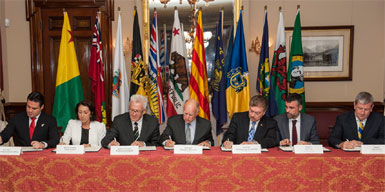With no time to waste, more and more we are seeing state and local governments take on climate change in the absence of strong national action.
12 governments representing 100 million people are the initial signatories to the "Under 2 MOU" – agreeing to take joint action that will keep global temperatures from reaching 2°C.
Governor Brown of California brought the group together in Sacramento saying the agreement "provides a template for the world’s nations to follow," and "This global challenge requires bold action on the part of governments everywhere. It’s time to be decisive. It’s time to act."
The 12 founding signatories include both advanced and developing economies and would collectively constitute the fourth largest economic entity in the world, with $4.5 trillion in GDP.
They are: California, Oregon, Vermont and Washington in the US; British Columbia and Ontario in Canada; Jalisco and Baja California in Mexico; Acre, a state in Brazil; Baden-Württemberg in Germany; Catalonia in Spain; and the country of Wales.

Signatories commit to reduce emissions 80-95% below 1990 levels by 2050 and/or to achieve per-capita emissions under 2 metric tons per year by 2050.
Among the ways they will collaborate:
- Develop mid-term milestones that reach the long-term emission goals;
- Share information and experience on how to redesign the power supply and grid, and technical solutions that promote a large-scale shift to renewable energy and energy efficiency.
- Achieve broad adoption of zero-emission vehicles; Encourage land use planning and development that supports zero emissions transit, especially mass transit, biking, and walking.
- How to sequester carbon and protect natural resources, as well as sharing technologies that reduce waste and increase recycling.
- Ensure consistent monitoring and reporting of greenhouse gas emissions;
- Improve air quality by reducing short-lived climate forcers such as black carbon and methane;
- Coordinate on messaging, transparency and public outreach on climate change.
According to the UN Development Program, 50-80% of the mitigation and adaptation actions necessary to tackle climate change will be implemented at the subnational or local levels of governance.
Last month, 17 of the world’s largest cities formed the Carbon Neutral Cities Alliance to support each other in their commitment to cut greenhouse gases 80% by 2050 – at a minimum. In the US, 10 cities are participating in the City Energy Project to significantly improve energy efficiency in buildings.
Read our article, 100% Renewable Energy Gaining Traction As Worldwide Goal, which lists cities that have that goal.
At the same time, corporations, investors and policymakers are in Paris for Climate Week. Investors launched The Investor Platform for Climate Actions website where their actions will be posted:
- Measurement, such as carbon footprinting of portfolios
- Engagement, such as with fossil fuel and energy intensive companies
- Reallocation, such as moving capital from emissions-intensive activities to low carbon assets
The IPCC states emissions must be cut 40-70% below 2010 levels by 2050 to have a good chance of keeping temperatures from rising more than 2°C.
Check out Under 2 MOU:
